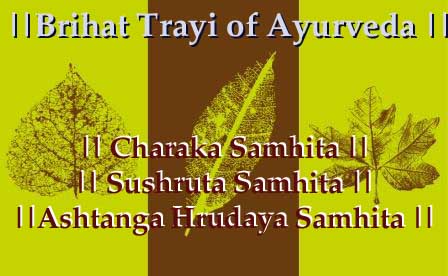Brihat Trayi: The 3 Treatises That Form The Foundation of Ayurveda
Article by Dr Manasa
Ayurveda, as all of us know is the most ancient medical science which has been serving the mankind in terms of providing a comprehensive, natural and holistic cure for many diseases related to body and mind, apart from being the best in providing basic formulas for prevention of diseases.
It took a lot of effort on the part of ancient Ayurvedic scholars to have formulated, scripted, edited, written and developed this science without the availability of any modern day sophistication.

The credit also goes to the Ayurvedic teachers and preachers who came in the medieval and modern era, who translated and re-edited these treatises into simpler language and made Ayurveda easy to understand.
References of Ayurveda found in Puranas, Vedas and many other ancient scriptures point towards the unpredictable periodicity of this medical system. We have references quoting that Ayurveda has descended from the creator Brahma himself. Ayurveda has been existing from time immemorial. Ayurveda is thus the pioneer and mother of all medical sciences. Therefore, Ayurveda is what its authors have made it to be.
Read related: How Ayurveda Originated? Detailed Explanation
Table of Contents
Brihat Trayees
Brihat Trayees
There are three main treatises which are considered most authentic and standard references for Ayurveda. These 3 treatises occupying the best positions for their authority and authentication with respect to compilation and presentation of Ayurveda in its best form are called as ‘Brihat Trayees’ or the ‘Elite three of Ayurveda’ or the ‘Greater Trio of Ayurveda’
Charaka Samhita,
Sushruta Samhita and
Ashtanga Sangraha are known as ‘Brihat Trayis’ (Brihat Trayees), meaning 3 great treatises or ‘greatest trio’ of Ayurveda.
Sushruta Samhita is regarded as the best and the oldest available standard reference for learning of Shalya Vijgnana (surgical methods).
In today’s article we shall discuss about Brihat Trayees, their authors and their contribution to the field of medical science.
Acharya Charaka
Acharya Charaka
Acharya Charaka is the author of Charaka Samhita, the first and foremost authentic treatises of Ayurveda, a standard reference for practice of general medicine
Charaka Samhita is a popular Ayurvedic treatise. As the name indicates, it is a compilation of Ayurveda lessons comprising of various aspects including basic concepts (Sutra sthana), diagnosis of diseases (Nidana sthana), treatment concepts (Chikitsa sthana) etc and is written by Charaka. (Charaka Samhita means ‘treatise written by Charaka).
Charaka – ‘the re-modulator of Charaka Samhita –
But actually the book is not originally written by Charaka. Acharya Charaka redacted the treatise ‘Agnivesha Tantra’ which has become popular in the name of ‘Charaka Samhita’. This means to tell that the text ‘Agnivesha Tantra’ written by Agnivesha was re-modulated by Charaka, which later came to be called as ‘Charaka Samhita’.
Charaka Samhita
Salient features of Charaka Samhita:
1. Samhkya philosophy is given importance.
2. It is more regarded as a general medicine-oriented book and the text book deals in detail regarding treatment for fever, digestive disorders etc.
3. Detailed and scientific explanation regarding daily healthy routine, seasonal routine, etc health maintenance procedures.
4. Methodical and scientific explanation regarding taste, qualities, potency of herbs and medicines.
3. Detailed and systematic explanation of disease (Vyadhi), classififaction of vyadhi, diagnostic tools for different diseases, examination method etc are we well documented.
4. Scientific and clear explanation of Panchakarma procedure.
Read more about Charaka Samhita, its contribution, commentators etc
Acharya Sushruta
Acharya Sushruta
Acharya Sushruta is the author of ‘Sushruta Samhita’ an Ayurvedic treatise which is a compilation of lessons related to basic concepts of Ayurveda, Anatomy and physiology of human body, causes and management of diseases, formulations, surgical methods, special treatments of Ayurveda like Panchakarma, Kshara karma, Agni karma, basics and details of toxicology and many other health related concepts.
Sushruta Samhita
Some specialities of Sushruta Samhita –
Detailed explanation regarding various surgical procedures such as cataract, rhinoplasty, renal calculi, intestinal obstruction etc
Methodical explanation about tools used for surgery, how to practice surgery? etc.
Scientific explanation regarding body types, human anatomy, embryology, method to conduct dissection, etc.
Ksharakarma, Agni Karma (Cautery), Jalauka (leech therapy), Blood letting therapy etc.
Read more about different sections of Sushruta Samhita, Commentary etc
Kalpa Sthana – Deals with toxicology covered in 8 chapters
Uttara Tantra –
Uttara Tantra is the 6th and the last division of Sushruta Samhita which has not been composed by Sushruta. It is believed to be an addition to the main treatise (original redactor) contributed by its redactor, Nagarjuna. It deals with various other subjects which were not discussed in the earlier divisions covered in 66 chapters.
Ashtanga Sangraha, Hridaya
Ashtanga Sangraha and Ashtanga Hridaya have glimpses of influence of Charaka Samhita and Sushruta Samhita. Both Ashtanga Sangraha and Hridaya were written by Vagbhata. Ashtanga Hridaya is the easiest one among the 2 in terms of comprehensive understanding. The language used by Vagbhata is worth appreciating. It is reachable to almost everyone who reads it of course with a good knowledge of Sanskrit. The translated versions can be understood by common people also.
The author himself says, ‘By churning the great ocean of medical science, a great store of nectar by name Ashtanga Sangraha was obtained. From that store of nectar has arisen Ashtanga Hridaya for the benefit of less intelligent people’. This shows that Vagbhata has taken excerpts and material from the pre-existing Ayurvedic treatises and has given it another shape, easier one. He simplified Ashtanga Sangraha and wrote Ashtanga Hridaya.
Read related: Ashtanga Sangraha and Hrudaya – introduction, sections, commentaries, importance








